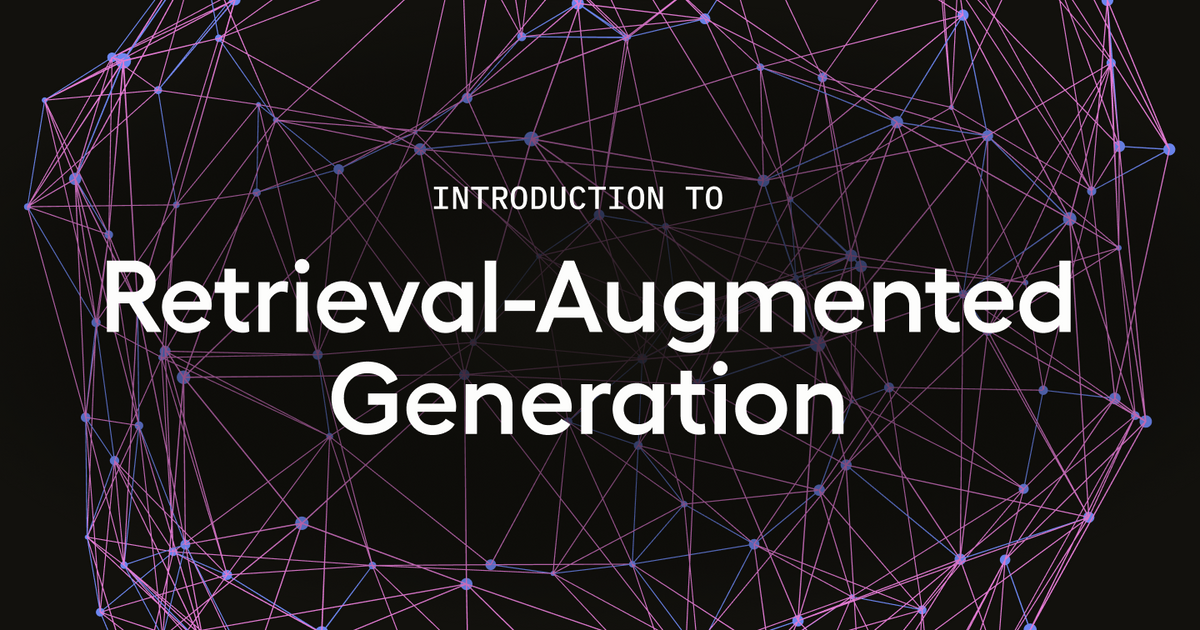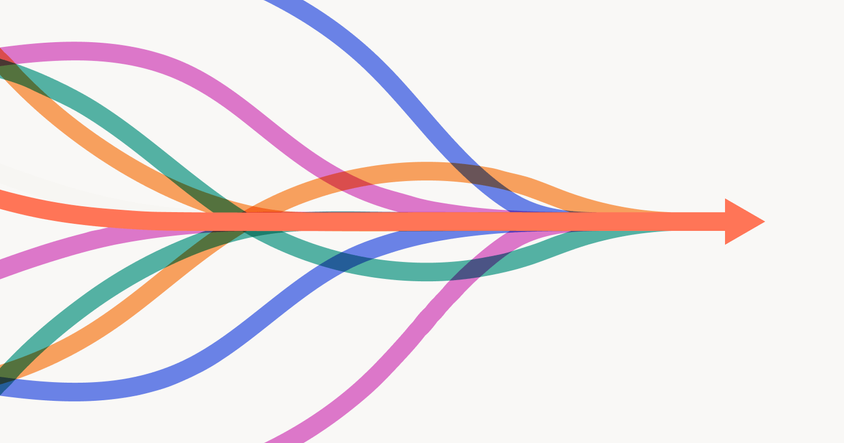An Introduction to Retrieval-Augmented Generation (RAG)

As data scientists and machine learning engineers, you’re likely already acutely aware of the inconsistencies present in large language models. One day they can provide fantastic responses with pinpoint accuracy, and other times seem to generate seemingly arbitrary or random acts they pull from their training data (or occasionally, out of thin air).
This is where the Retrieval-Augmented Generation (RAG) comes in handy. RAG can act as a kind of anchor for LLMs by integrating them with external sources of knowledge, such as a vector database or other information systems. What this does is, in essence, supplement their outputs with concrete, verifiable, up-to-date facts.
This provides you with two major benefits: it enhances the factual accuracy of the responses and introduces transparency by providing insight into the sources utilized during the generative process. This transparency is crucial, as it allows for the validation of the LLMs' outputs, establishing a foundation of trust in their responses - an invaluable asset in data science when it comes to training (fine-tuning) and production. It also helps prevent AI “hallucinations,” as the model’s responses are grounded in specific resources.
In this article, we’ll provide a brief overview of RAG and how it relates to LLMs, answer the question of when you might consider using RAG, and present some challenges based on current research you should be aware of should you choose to travel down this path. Let’s jump right in.
A quick refresher on large language models (LLMs)
Large Language Models (LLMs) represent a cutting-edge advancement in artificial intelligence, harnessing deep learning techniques, particularly transformers, to emulate human-like text generation. These complex systems boast neural networks with potentially billions of parameters and are trained on vast datasets drawn from numerous text forms, including academic literature, blogs, and social media.
In AI applications, LLMs are pivotal, offering unparalleled natural language processing that supports a spectrum of language-related tasks. These range from translating human language for computer understanding to crafting sophisticated chatbot interactions and tailoring content to user preferences. In the commercial sector, LLMs, such as GPT-4.0, have revolutionized the comprehension of human language, leading to the emergence of nuanced, context-sensitive chatbots, the automation of repetitive tasks to boost productivity, and the facilitation of language translation, thus bridging cultural divides.
Despite their capabilities, LLMs are not without challenges. They occasionally falter in generating content rich in context, and their output may be marred by inaccuracies or a lack of specialized knowledge—flaws that often reflect the quality of their training data. Furthermore, these models are typically limited by what they have been trained on, lacking an innate ability to grasp concepts with common sense reasoning as humans do.
Retrieval-Augmented Generation (RAG) has been introduced to overcome these drawbacks. RAG enhances LLMs by supplying them with pertinent information that complements the task at hand, thus significantly improving the model’s proficiency in producing accurate and context-aware responses. RAG equips LLMs to address queries about subjects outside their original training corpus through a methodical process that includes data preparation, relevant information retrieval, and response generation using the retrieved data. This innovation aims to curtail inaccuracies and reduce the occurrence of 'hallucinations,' where models generate believable but incorrect or nonsensical content.
In essence, while LLMs are indispensable tools in the AI landscape for text processing and generation, they are continually evolving. Innovations like RAG are enhancing their effectiveness, ensuring outputs are more precise and contextually relevant. Now, we’ll explore a little more about what RAG is and its advantages.
What is Retrieval-Augmented Generation (RAG)?
Retrieval-Augmented Generation (often abbreviated as RAG) is a machine learning framework that combines two fundamental aspects of natural language processing: information retrieval and text generation. RAG aims to generate coherent and contextually relevant text based on a given prompt or query while leveraging external knowledge from a set of pre-existing documents or a knowledge base.
RAG is comprised of two components that work together:
Retrieval Component
The first piece of RAG is the retrieval component. This component is responsible for finding relevant documents or passages from a collection of text data related to the input query or prompt. It usually employs techniques such as dense passage retrieval (DPR), where documents are encoded into high-dimensional embeddings, and then uses efficient nearest-neighbor search methods to retrieve the most relevant documents or passages.
Put another way, the retrieval component requires a database of knowledge that uses some sort of encoding to capture similarity, frequently done with a vector embedding model. This vector-encoded database becomes the source that's used to augment the knowledge of the LLM. The key thing to know about vector embeddings is that they help capture contextual knowledge in a mathematical way, making it possible to know things like the phrase "sand bar" is very different from the phrase "dive bar."
Thus, when a query is made, the model computes an embedding for it, which it then compares to the embeddings in the knowledge database. With that information, the most relevant documents to the query are then used to augment the query.
This works for a couple of reasons. The first reason is that input buffers to LLMs are getting much larger, and you can add a lot of contextual information to help them generate better answers. The second has to do with the transformer-based attention mechanism that LLMs use that allow it to act on the context in the buffer in conjunction with the general knowledge and language skills of the model.
Generation Component
The second piece of RAG is the generation component. Once the relevant documents or passages are retrieved, they are used as context or knowledge to guide text generation. This generation component can be based on various language models like GPT-3, GPT-4, or other transformer-based models. The retrieved information can be used as input to condition the generation process, providing context and helping generate more contextually relevant responses.
Why Use Retrieval-Augmented Generation?
There are a few reasons why you might want to consider using RAG for your project:
- Incorporating external knowledge: RAG allows models to generate text enriched with information from external sources, making the generated content more accurate and informative.
- Improved contextual relevance: By leveraging relevant documents or passages, RAG models can generate contextually relevant text to the input query or prompt, improving the quality of responses.
- Flexibility: RAG models can be applied to various natural language processing tasks, including question answering, text summarization, content generation, and more, by conditioning the generation process on retrieved information.
RAG models have been used in various applications, including chatbots, content generation, and question-answering systems, where they can provide more accurate and contextually appropriate responses by integrating external knowledge. These models are often fine-tuned on specific tasks and datasets to optimize their performance for particular applications.
How fine-tuning LLMs can impact RAG model performance
While RAG doesn’t necessarily require using an LLM to implement, in many cases, it’s easier to train an LLM in both the retrieval and generation components of your RAG model. While this can be more resource-intensive, it can also help you get your RAG model off the ground more quickly. It can also add adaptability and correction capabilities to the access to external data and RAG’s transparency in responses, giving you the best of both worlds.
Another potential use case for LLMs with regard to RAG has been outlined by Databricks in this case study. They are using LLMs to evaluate the efficacy of the responses from their RAG-based documentation chatbot with great success by doing zero-shot learning with GPT4 to establish grading rules and then one-shot learning with GPT3.5 to do the evaluation in production.
So what’s the role of fine-tuning in all this? Well, in the event that you’re using an LLM like ChatGPT4 for a RAG application, fine-tuning can help boost model performance and reliability. Remember that adaptability and correction capability we mentioned? It’s LLM fine-tuning that unlocks this. Fine-tuning your RAG LLM can help the model avoid repeating mistakes, learn a desired response style, or learn how to handle rare edge cases more effectively, (or provide more accurate assessment of chatbot results) among many other things.
Things to consider and look out for when implementing RAG
Implementing RAG is not without its challenges. Some of these problems come from a lack of common workflows and benchmarks for RAG, but some simply stem from the inherent complexity of integrating retrieval systems with generative models. Let’s dive into a few notable examples, in no particular order:
- Noise robustness: One of the key challenges is ensuring that LLMs can distinguish useful information within noisy documents which are relevant to a query but do not directly answer it. For instance, noisy documents might provide information about a related but different event or topic, confusing the model and resulting in incorrect answers.
- Negative rejection: LLMs must recognize when the necessary knowledge is absent in the retrieved documents and consequently reject answering the query. This is particularly difficult as it requires the model to understand the limits of its knowledge and to communicate these boundaries clearly to users.
- Information integration: This involves the capability of LLMs to synthesize information from multiple documents to answer complex queries. Effective information integration is critical, especially when no single document contains all the necessary information, and the model must piece together fragmented information across several sources.
- Counterfactual robustness: LLMs should be able to detect and disregard known factual errors in the retrieved documents, even when they are warned about potential inaccuracies. This requires the model to balance skepticism with the ability to trust its stored knowledge over potentially flawed external information.
- Context relevance and query matching: The effectiveness of a RAG system is significantly dependent on the precision with which the query matches the documents in the vector database. If the similarity search is limited by the metrics implemented for embeddings, the context retrieved may not be fully relevant, which can lead to incomplete or incorrect responses.
- Periodic indexing of data: Maintaining the vector database requires regular updates to include new data. This is essential for the RAG system to retrieve the most current and relevant documents for queries. However, it can be resource-intensive and requires a consistent strategy to ensure knowledge databases remain up-to-date and comprehensive.
- Lack of sufficient benchmarks: Furthermore, there is a significant gap in evaluating RAG applications, primarily due to the lack of industry-wide standards. This has led to reliance on labor-intensive human grading that doesn't scale efficiently. While LLMs have been proposed as automated judges to overcome this, aligning their assessments with human preferences and ensuring the transferability of evaluation metrics across various RAG use cases remains a challenge. This indicates that specific and rigorous benchmarks are necessary for different RAG applications to ensure reliable performance across tasks.
- Evaluation of chatbot responses: Establishing the quality of chatbot responses, which is essential for RAG applications, is difficult due to the absence of industry standards, leading organizations to rely on time-consuming and hard-to-scale human grading.
Conclusion and looking ahead
Retrieval-augmented generation holds great promise in helping overcome many of the current limitations of LLMs. As RAG methodologies and benchmarks continue to develop, it may prove key to getting us one step closer to making AI-generated content indistinguishable from that created by humans.
That brings us to HumanSignal and our stance on RAG. We believe RAG will play a significant role in the continued evolution of NLP and LLMs. Today, we support various methods to fine-tune foundation models, including a ranker interface we released in June, making Label Studio a valuable tool in fine-tuning LLMs for use with RAG. Our platform also supports several relevant labeling templates to get you started if you feel so inclined.
Looking ahead to the future, the team here at HumanSignal is actively investigating support for RAG within our platform, including our Data Discovery feature. This is particularly exciting for us, as RAG can be accomplished via embeddings, and embeddings can be added and queried within Data Discovery - a perfect combo when paired with our labeling and fine-tuning capabilities. Be sure to keep checking back here for more updates! In the meantime, our expert team of humans would be happy to chat with you if you’d like to learn more about our platform, including the ability to fine-tune chatbots and LLMs.


